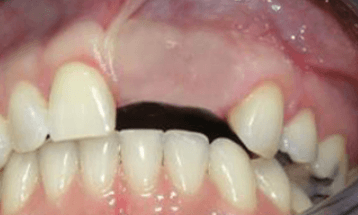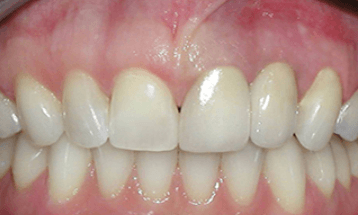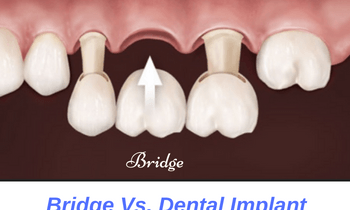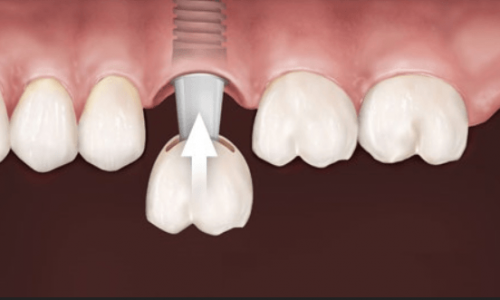A dental bridge is a fixed dental prosthesis that replaces one or more missing teeth by closing the gap in between existing teeth. Essentially, a bridge is three or more crowns connected to one another to bridge a gap. Bridges are fixed prostheses, meaning that they stay in your mouth permanently. Bridges stay in place by attaching to your natural teeth. In order to receive a bridge, your dentist will shave two or more teeth next to the gap(s). The teeth used to anchor the bridge are known as abutments and the missing teeth are known as pontics. Typically, you need to have at least one tooth in front and one behind the missing gap in order to create a successful bridge. Placing a bridge is no longer an option if you're missing terminal teeth. Schedule a consultation with your dentist to learn more about bridges to see if you're a candidate.
What are the benefits of a bridge?
Bridges replace your missing teeth with a fixed dental restoration. You shouldn't ignore gaps in your mouth that result from missing teeth. Neglecting to replace your missing teeth leads to many problems that can affect your whole mouth. Here are some consequences of leaving gaps in your mouth:
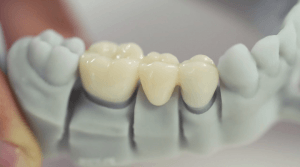
Missing teeth lead to bite issues, increased risk of cavities, and damage to the remaining teeth
Bite Problems
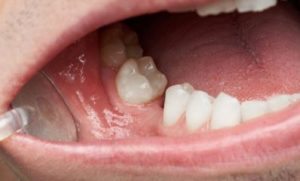
The teeth in front, behind, and opposing the missing tooth start moving into the missing gap
Increased Risk of Developing Additional Dental Problems
Having a missing tooth makes it much harder to properly clean your teeth. Most people fail to clean the gaps created by missing teeth. This is especially true of teeth adjacent to the gap. As a result, you're much more likely to develop cavities on the teeth next to the gap. If left untreated, these cavities lead to an infection and cause you to lose even more teeth. Consequently, a single missing tooth can cause you to lose a whole bunch of teeth over time.
Increased Stress on the Remaining Teeth
Many people assume that losing a single tooth is just not that big of a deal. After all, we have twenty-eight adult teeth, so how important could losing one tooth really be? This is actually not true. Every time that you lose a tooth, you increase the stress exerted onto your remaining teeth. Losing a single back tooth increased the stress on the remaining teeth by 10 to 15%. This added stress increases the chances of your remaining teeth cracking and breaking over time. The more teeth that you lose, the more stress is placed on your remaining teeth. This causes an avalanche effect leading to even more tooth loss over the years. As you can see, it's always best to replace your missing teeth to protect the existing ones. You can prevent your remaining teeth from shifting by placing a bridge to replace your missing tooth. This makes it easier to maintain proper hygiene, protects your bite from collapsing, and supports your remaining teeth.
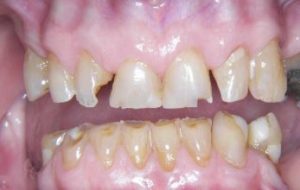
The more teeth that you lose, the more stress you place on your remaining teeth
Is a bridge a better option than a denture?
There are three common ways to replace a missing tooth. One of them is a bridge, the other a dental implant, and lastly, a denture. Typically, a dental bridge is preferred over a denture for the following reasons:
- Bridges are fixed in your mouth whereas dentures are removable.
- With a bridge, you get superior chewing capacity similar to natural teeth. On the other hand, dentures only offer about 20 to 50% chewing capacity as compared to natural teeth.
- Bridges feel like your own teeth as they are fixed in the mouth. Wearing dentures can be awkward and uncomfortable at times.
Is a bridge a better option than a dental implant?
A dental implant is a better treatment option than a bridge in almost all circumstances. There are several reasons why dentists usually recommend going with a dental implant over a bridge:
- Do no harm - Placing a dental implant does not require any damage to your remaining teeth. On the other hand, in order to place a bridge your dentist must shave at least the two neighboring teeth. Shaving your natural teeth can cause problems, such as cavities or infections. It's not uncommon to have to require a root canal or even lose one of the supporting teeth over time. This causes your bridge to fail, leaving you with one or more missing teeth than before you received your bridge!
- Better hygiene - Dental implants are easy to clean. You can clean your dental implants like you clean natural teeth. Cleaning underneath a bridge can be quite challenging and requires special instruments. Sometimes you simply can't clean this area and end up with a constant food trap underneath your bridge.
- No need for adjacent teeth - Many times placing a bridge is not even an option and you can only replace the missing tooth with a dental implant. In order to qualify for a bridge, you must have at least one healthy tooth on each side of the gap. If you're missing a terminal tooth, have multiple missing teeth, or teeth that suffer from gum disease, you won't qualify for a bridge.
As you can see, dental implants are superior to bridges in almost all situations. Now, we're not saying that you should never place a bridge on your teeth. There are some scenarios where placing a bridge makes more sense than a dental implant. Here are a few examples of these exceptional cases:
Full Mouth Rehabilitation
Full mouth rehabilitation is when your dentist places a crown on just about every single tooth in your mouth. This treatment option is reserved for people with a severely collapsed bite. During full mouth rehabilitation, a bridge is commonly used instead of dental implants. If the teeth adjacent to a missing gap require crowns, then placing a bridge makes more sense than going for a dental implant. After all, the whole point of avoiding a bridge is not to have to shave your teeth. However, if these teeth already require a crown, then why not just convert them into a bridge and skip the implant surgery? This saves you time and money without adversely affecting the treatment outcome.
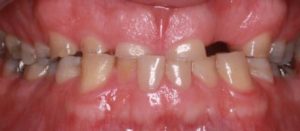
If teeth adjacent to a missing gap require crowns then placing a bridge might make more sense than going for a dental implant
Insufficient/ Poor Quality Jawbone
Occasionally, there is not enough jawbone to place a dental implant without extensive bone grafting. Not everyone wants to go through this process. You may be faced with a situation where you either need a sinus graft or you can receive a bridge instead. Maybe you have had cancer treatment or osteoporosis medications and your bone quality is not up to par for implant treatment. It might make sense to go for the bridge over the dental implant. You will have your bridge in a few weeks whereas complex implant treatments take months, sometimes even years. Plus, you will save thousands of dollars in the process. Of course, you should always make the decision that is best for your mouth and body. However, sometimes it just makes more sense to go with the bridge option over the dental implant.
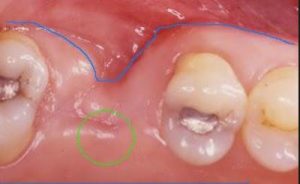
Sometimes you have to perform extensive bone grafting to restore the jawbone for dental implants
Closing Small Gaps
Occasionally, the gap between your two teeth is simply too narrow to fit a dental implant. You need a minimum of six to seven millimeters to successfully place an implant post in the jawbone. If there isn't enough space to place the implant post then a bridge might be your only option. If you really want the implant, you might be able to wear braces or clear aligners to open up the gap and place the dental implant. However, not everyone wants to go through orthodontic treatment. Placing a bridge can close small gaps without the need for braces and dental implants.
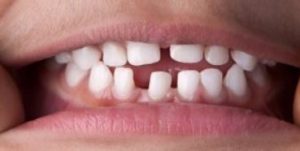
If there isn't enough space to insert a dental implant then placing a bridge might be your only option
